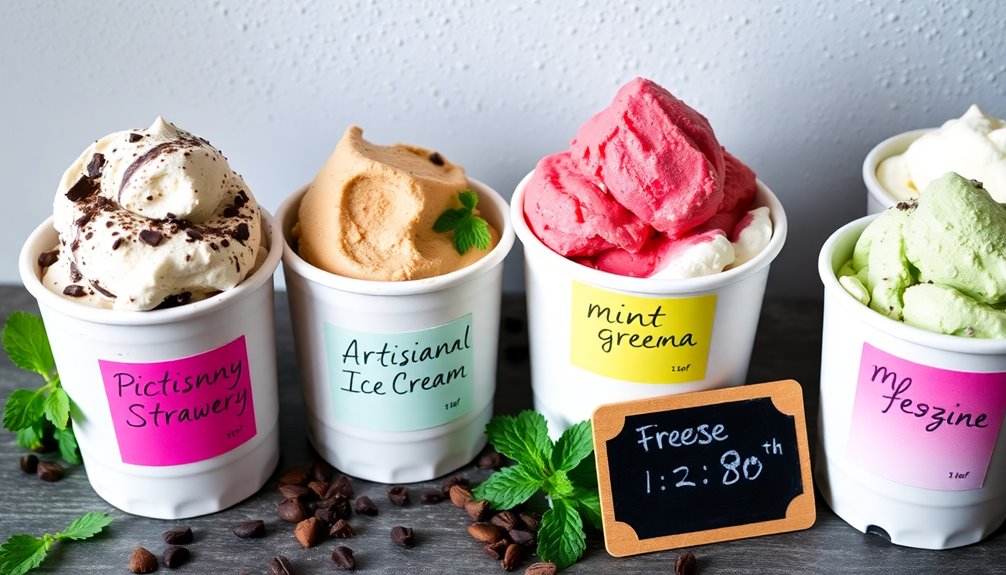Proper labeling and dating of ice cream are essential for ensuring its freshness and quality. Always check for production and expiration dates, as these indicate safe consumption periods. Look for clear ingredient lists and nutritional information to make informed choices. A well-labeled ice cream helps minimize food waste and enhances your enjoyment. To keep your treats fresh, understanding storage practices and spoilage signs is important, and there’s plenty more to uncover about this topic.
Key Takeaways
- Clearly mark production dates in the format FP: day – month – year for tracking freshness.
- Use standardized labels like “BEST If Used By” and “USE By” to indicate safe consumption periods.
- List ingredients from highest to lowest weight for transparency, including potential allergens.
- Offer detailed nutritional information, including caloric intake and key nutrient breakdowns.
- Monitor expiration dates and signs of spoilage, such as ice crystals and off-flavors, to ensure quality.
Importance of Proper Labeling for Ice Cream Freshness

When you enjoy a scoop of homemade ice cream, knowing how fresh it is can make all the difference. Proper labeling plays an essential role in ensuring you track the freshness of your treat. By clearly marking production and expiration dates, you can confidently consume your ice cream within the recommended timeframes.
This transparency helps you avoid any guesswork about its safety. Additionally, standardizing labels with terms like “BEST If Used By” and “USE By” clarifies freshness expectations, guiding your decisions.
You’ll also appreciate knowing the ingredients and nutritional information, which promote safety and cater to health-conscious choices. Ultimately, effective labeling not only enhances your ice cream experience but also helps reduce food waste. Furthermore, being aware of the high sugar and fat content in ice cream can assist you in making informed choices about your consumption.
Key Components of an Effective Ice Cream Label

To guarantee you get the best out of your ice cream experience, an effective label must highlight several key components.
First, it should clearly state the production date in the format FP: day – month – year, allowing you to track freshness easily.
Next, look for expiration dates; these indicate a safe consumption period of more than 30 days from production.
The ingredients list is equally vital, ordered from highest to lowest weight, promoting transparency about what you’re consuming.
Nutritional information should detail caloric intake and breakdowns of carbs, sugars, fats, fiber, and proteins.
Finally, potential allergens like gluten, lactose, and nuts must be clearly listed to enhance safety and build your confidence in the product.
Understanding Expiration Dates and Shelf Life

When it comes to ice cream, understanding expiration dates is essential for your safety and enjoyment.
You’ll want to manage shelf life effectively to guarantee every scoop is fresh and delicious. Knowing how long your homemade treat lasts can help you avoid spoilage and maximize flavor.
Importance of Expiration Dates
Expiration dates play an essential role in helping you determine the freshness and quality of ice cream.
These dates indicate the period during which the ice cream will maintain its ideal taste, usually lasting more than 30 days if stored correctly. While ice cream can be safe to consume for up to three to four months, its flavor starts to decline after six weeks.
That’s why monitoring expiration dates is important. Proper labeling is significant, as consumer confusion over date formats often leads to unnecessary food waste—almost two million tons annually.
Shelf Life Management Tips
Understanding how to manage the shelf life of ice cream can help you enjoy its freshness longer.
To maximize how long your ice cream lasts, always store your ice cream in an airtight ice cream container. This prevents ice crystals and freezer burn, keeping the texture smooth. Aim to consume opened ice cream within seven to ten days for the best quality.
Unopened, it can stay fresh for two to three months at 0°F (-18°C). Keep your ice cream in the coldest part of the freezer, away from the door, to maintain a steady temperature.
Watch for signs of spoilage like large ice crystals or off-flavors, indicating it’s time to toss it out.
Best Practices for Storing Ice Cream

To guarantee your ice cream stays fresh and delicious, follow these essential storage tips:
- Store homemade ice cream in airtight containers filled to the top to minimize air exposure and prevent ice crystals.
- Transfer ice cream to the freezer immediately after churning for ideal storage and maintain quality for up to one month.
- Keep your freezer at 0°F (-18°C) or lower and place ice cream containers in the back, away from the door for stable conditions.
- Use effective sealing methods, like covering the surface with plastic wrap, to protect against freezer burn.
Signs of Spoilage in Ice Cream

When you notice ice crystals forming on your ice cream, it’s a sign that air has gotten in and it might be freezer burnt.
If you detect off-flavors or unusual odors, that could indicate spoilage and potential bacterial growth.
Always trust your senses—if something seems off, it’s better to toss it than risk your health.
Ice Crystal Formation
Ice crystal formation on ice cream isn’t just an aesthetic issue; it signals potential spoilage that can affect taste and safety.
When you spot ice crystals on the surface, it’s a sign that air exposure has occurred, leading to freezer burn.
Here are some key indicators of spoilage:
- Large ice crystals suggest thawing and refreezing.
- A sticky or gooey texture may indicate bacterial growth.
- Excessive ice shards on the lid or surface signal that it’s time to discard.
Monitoring the formation of ice helps guarantee your ice cream stays enjoyable and safe. Consuming ice cream with ice crystal formation can lead to an unpleasant experience and compromise quality.
Off-Flavors and Odors
While enjoying your favorite ice cream, you might notice off-flavors or unusual odors that could signal spoilage. These changes can indicate that the cream has gone bad, often due to bacterial growth or the absorption of odors from other foods in your freezer.
If you detect a sour or rancid taste, it’s a clear sign that quality has degraded. Additionally, the presence of ice crystals on the surface suggests freezer burn, affecting both texture and flavor, making your treat less enjoyable.
Regularly checking for these signs helps you identify spoilage early, ensuring safer consumption and better-tasting ice cream. Trust your senses—if it doesn’t taste or smell right, it’s best to toss it out.
The Role of Consumer Education in Reducing Food Waste

Here are some key points to reflect on:
- Recognize the difference between “Best By,” “Use By,” and “Sell By” dates.
- Understand that many products are still safe to consume after these dates.
- Use resources like the USDA FoodKeeper app for guidance on food storage and shelf life.
- Engage your senses—smell and texture can help determine freshness.
- Educating yourself about cookie consent preferences can also lead to better food choices and reduce waste.
Future of Ice Cream Labeling and Quality Assurance

As consumers seek clearer guidance on food safety, the future of ice cream labeling and quality assurance is set to undergo significant changes. Standardized date labels will enhance your understanding of ice cream freshness, reducing confusion and waste. With proposed labels like “BEST If Used By” and “USE By,” you’ll know when quality and safety are at risk.
Here’s a visual representation of these changes:
| Label Type | Purpose |
|---|---|
| BEST If Used By | Indicates ideal quality |
| USE By | Indicates safety |
| Consumer Education | Essential for understanding |
| Food Waste Reduction | Prevents unnecessary disposal |
Frequently Asked Questions
How to Read Ice Cream Expiration Date?
To read an ice cream expiration date, first locate the date printed on the container. It usually follows the day-month-year format.
Pay attention to the distinction between “Best By” and “Use By” dates; the former suggests ideal taste, while the latter indicates safety concerns.
If you notice any ice crystals or off-odors, it’s time to toss it, even if the date hasn’t passed.
Always prioritize your safety and enjoyment!
How to Properly Label and Date Food?
Imagine opening your pantry and finding neatly labeled jars, each with a date that dances across the label like a reminder of yesterday’s feast.
To properly label food, you’ve got to include the production date and an expiration date. List ingredients in order of weight, and highlight allergens.
Don’t forget nutritional info to cater to health-conscious friends. This transparency not only builds trust but also keeps everyone safe and informed about what they’re consuming.
How to Determine the Shelf Life of Ice Cream?
To determine the shelf life of ice cream, check its storage conditions and packaging.
If it’s stored in an airtight container at 0°F (-18°C) or lower, it can last up to a month for peak quality. Opened ice cream stays fresh for about six weeks, while unopened can last two to three months.
Always look for signs like large ice crystals or off-flavors, as these indicate it may be time to discard it.
How Long Is Ice Cream Good for After Use by Date?
Ever wondered how long your ice cream lasts after that “use by” date? If stored properly at zero degrees Fahrenheit, it can remain safe for three to four months.
However, for the best taste and quality, aim to enjoy it within one to two months.
Keep an eye out for signs of spoilage, like large ice crystals or off-flavors. If you notice these, it’s best to toss it out for your health’s sake.
Conclusion
In the world of ice cream, knowing how to read labels and understand freshness can make all the difference. By keeping an eye on expiration dates and following best storage practices, you’ll guarantee your treats stay delicious for longer. Remember, a little knowledge goes a long way in reducing food waste. So, don’t let good ice cream go to waste—stay informed, and you’ll always have a scoop of happiness at hand!










